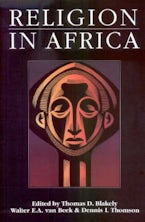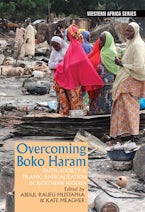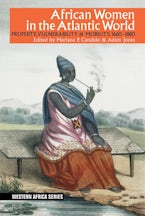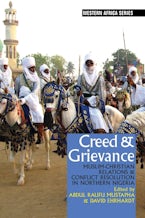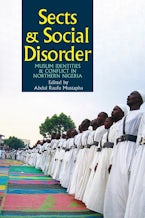
Title Details
414 Pages
23.4 x 15.6 cm
5 maps, 41 colour, 29 b/w and 6 line illus.
Series: Western Africa Series
Series Vol. Number:
20
Imprint: James Currey
Masquerades in African Society
Gender, Power and Identity
- Description
- Contents
- Author
- BLOG POST
Explores the dynamics of African masquerades and mask performances on the continent, linking performative expressions to societal characteristics.
What is the meaning of masks and masquerades in African traditions and how can we understand their role in rituals and performances? Why do we find masks in some African regions and not in others, and what does this 'mask habitat' say about the general dynamics of masquerades in Africa? Though masks are among the most famous art icons of Africa, exploration of their uses and the way in which they articulate social characteristics of African societies has been underexamined. This book takes an anthropological perspective on the phenomenon of masquerades on the African continent to show how mask rituals are an integral part of African indigenous religions and societies, and are informed by and linked to specific types of social and ecological conditions. Having established the commonalities of mask rituals and a mask typology, the authors look at the varieties of mask performances and the types of rituals in which masks function in rites of passage and in rituals of gender, power, and identity. The following chapters focus on different types of rituals featuring masks, from initiation and death ceremonies to secrecy, kingship, law and war. With its broad examination of the use of masks on the continent, from Angola to Burkina Faso, Cameroon, DRC, Guinea, Ivory Coast, Liberia, Mali, Nigeria, Senegal, this well illustrated book will stand as an authoritative study of the use of masks, of interest not only to those in African Studies but to anthropologists and ethnographers worldwide.
What is the meaning of masks and masquerades in African traditions and how can we understand their role in rituals and performances? Why do we find masks in some African regions and not in others, and what does this 'mask habitat' say about the general dynamics of masquerades in Africa? Though masks are among the most famous art icons of Africa, exploration of their uses and the way in which they articulate social characteristics of African societies has been underexamined. This book takes an anthropological perspective on the phenomenon of masquerades on the African continent to show how mask rituals are an integral part of African indigenous religions and societies, and are informed by and linked to specific types of social and ecological conditions. Having established the commonalities of mask rituals and a mask typology, the authors look at the varieties of mask performances and the types of rituals in which masks function in rites of passage and in rituals of gender, power, and identity. The following chapters focus on different types of rituals featuring masks, from initiation and death ceremonies to secrecy, kingship, law and war. With its broad examination of the use of masks on the continent, from Angola to Burkina Faso, Cameroon, DRC, Guinea, Ivory Coast, Liberia, Mali, Nigeria, Senegal, this well illustrated book will stand as an authoritative study of the use of masks, of interest not only to those in African Studies but to anthropologists and ethnographers worldwide.
Introduction
- Enter the mask
- The study of masking
- Structure of the book
The Masking Crescent: Distribution of Masks and Masking in Africa
1. Mask Distribution and Theory
- Masking zones
- Theoretical approach
- Parameters of masking
- Profiles of masking societies
- The zebu exclusion
- Methodology
2. What is a Mask
- Explaining masks: The Magritte effect
- A basic mask typology
- Bush, spirits, ancestors, and other people
- Masks and power
- Tradition, prototype and invention
- Conclusion
3. Masks and Masculinity: Initiation
- Chewing the mask
- Separation from the mother
- Liminal revelation
- Mask and circumcision
- Symbols of gender: Death and food
- Communitas and age
- Masks and masculinities
- Conclusion
4. Secrecy and Power
- Writing on the mask
- Dimensions of secrecy
- Initiation societies and the empty secret
- The sound of secrecy
- Ethics, society, and secrecy
- Conclusion
5. Death and its Masks
- Singing at the mask
- Burial and the farewells
- Burial by masks
- Funeral as initiation
- Individual and society in funerals
- Masks and the second funeral
- Celebrating life
- Conclusion
6. Women: Pivot of the Masks
- The first mask
- Gender domains
- Celebrating femininity
- Women dancing with masks
- The mask of the woman is her body
- Conclusion
7. Masks and Politics
- Masks for father
- Masks and the history of the patriline
- Feasting the sultan
- The mask as king
- Initiation, masks, and regicide
- Masquerades and modern politics
- Conclusion: The Akan gap
8. Masks and the Order of Things
- Masks in the field
- Masks and the adjudication of law
- The discourse on witchcraft
- Masks versus 'witches'
- 'Uncovering witchcraft': A mask performance abroad
- 'War masks'
- Conclusion
9. Masks and Modernity
- Playful sharks in the Delta
- Theatre at Cross River
- The king of masks, the elephant of masks
- Masks for new audiences
- Masks as icons of ethnic identity
- Heritage, icon, and commodity
- Conclusion
10. Memories of Power, Power of Memories
- Arrest that mask!
- Satire, the weapon of the weak
- Masquerades and the slaving state
- From Africa to the African Diaspora
- Conclusion
11. Conclusion
- The cultural niche for masquerades
- A future for masks?
Bibliography
Sources for ethnographic cases
Picture credits
Index
- Enter the mask
- The study of masking
- Structure of the book
The Masking Crescent: Distribution of Masks and Masking in Africa
1. Mask Distribution and Theory
- Masking zones
- Theoretical approach
- Parameters of masking
- Profiles of masking societies
- The zebu exclusion
- Methodology
2. What is a Mask
- Explaining masks: The Magritte effect
- A basic mask typology
- Bush, spirits, ancestors, and other people
- Masks and power
- Tradition, prototype and invention
- Conclusion
3. Masks and Masculinity: Initiation
- Chewing the mask
- Separation from the mother
- Liminal revelation
- Mask and circumcision
- Symbols of gender: Death and food
- Communitas and age
- Masks and masculinities
- Conclusion
4. Secrecy and Power
- Writing on the mask
- Dimensions of secrecy
- Initiation societies and the empty secret
- The sound of secrecy
- Ethics, society, and secrecy
- Conclusion
5. Death and its Masks
- Singing at the mask
- Burial and the farewells
- Burial by masks
- Funeral as initiation
- Individual and society in funerals
- Masks and the second funeral
- Celebrating life
- Conclusion
6. Women: Pivot of the Masks
- The first mask
- Gender domains
- Celebrating femininity
- Women dancing with masks
- The mask of the woman is her body
- Conclusion
7. Masks and Politics
- Masks for father
- Masks and the history of the patriline
- Feasting the sultan
- The mask as king
- Initiation, masks, and regicide
- Masquerades and modern politics
- Conclusion: The Akan gap
8. Masks and the Order of Things
- Masks in the field
- Masks and the adjudication of law
- The discourse on witchcraft
- Masks versus 'witches'
- 'Uncovering witchcraft': A mask performance abroad
- 'War masks'
- Conclusion
9. Masks and Modernity
- Playful sharks in the Delta
- Theatre at Cross River
- The king of masks, the elephant of masks
- Masks for new audiences
- Masks as icons of ethnic identity
- Heritage, icon, and commodity
- Conclusion
10. Memories of Power, Power of Memories
- Arrest that mask!
- Satire, the weapon of the weak
- Masquerades and the slaving state
- From Africa to the African Diaspora
- Conclusion
11. Conclusion
- The cultural niche for masquerades
- A future for masks?
Bibliography
Sources for ethnographic cases
Picture credits
Index
Hardcover
9781847013439
October 2023
£90.00 / $135.00
Ebook (EPDF)
9781805430957
October 2023
£24.99 / $29.95
Title Details
414 Pages
2.34 x 1.56 cm
5 maps, 41 colour, 29 b/w and 6 line illus.
Series: Western Africa Series
Series Vol. Number:
20
Imprint: James Currey






